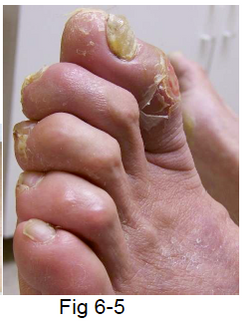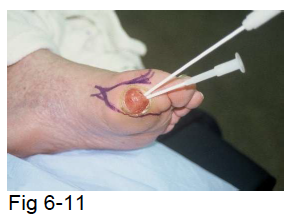Chapter 6 – Bunions, corns, calluses and ulcers
Chapter 6 – BUNIONS, CORNS, CALLUSES AND ULCERS
One of the most common causes of diabetic foot amputations is neglected calluses (see Fig. 6-1). When these calluses progress to form ulcers and subsequently become infected, gangrene may develop (see Fig. 6-2).


Hyperkeratosis is the medical term for callus formation. “Hyper” means excessive, and “keratosis” refers to thickening of the skin (or the stratum corneum). In diabetic patients, hyperkeratosis occurs due to increased cell proliferation and rapid thickening of the germinal layer, resulting in a firm mass of callused skin. Excessive keratinization produces thick, hard calluses. When hyperkeratosis occurs on the top of the toes, it is referred to as a corn, while on the bottom of the foot it is called a callus. If hyperkeratosis develops between the toes, it is known as a soft callus.
Fig. 6-3 Callus between the toes is called soft corn
Neuropathy—especially motor neuropathy—affects the muscles and tendons of the foot, leading to various deformities such as contractures of the toe joints. Additionally, irritation and pressure from shoes result in increased hyperkeratosis.
The changes in the diabetic foot are so gradual that many patients are unaware of the severity of the problem until a seemingly "small callus" leads to amputation. Although most diabetics know there is a risk of foot infection and amputation, very few understand why these issues occur or what preventive measures must be taken. This lack of concern about calluses can contribute to a poor prognosis. It is well known that patient education is critical for preserving the legs for life. While motivating diabetic patients to engage in preventive care, such as choosing the right shoes and using appropriate inserts (see Chapter 10), can be challenging, well-educated patients are more likely to maintain healthy feet despite extensive neuropathy and circulation problems.
Common foot deformities in diabetics include hammer toes, bunions, and bunionettes (see Fig. 6-4, which shows an enlargement of the fifth toe joint similar to a bunion), as well as calluses on the sole and soft calluses in the middle of the toes (see Fig. 6-3). Hammer toes typically develop from an imbalance of the tendons on the top and bottom of the foot. Continuous pressure and friction from poorly fitting shoes cause the skin on the toe to thicken and harden. With ongoing pressure, the callus may eventually rupture and ulcerate (see Fig. 6-5). Corns on the top of the hammer toes can progress into infected ulcers (see Fig. 6-6).
When a callus ulcerates, the toe joint may become infected. Occasionally, the callus on
the tip of the toe can also ulcerate due to friction from the insole of the shoe (see Fig. 6-
7).

When the toes rotate, the nails may dig into adjacent toes—acting like a knife and producing small ulcers (see Fig. 6-8). Pointed shoes can crowd the toes and increase friction between them, leading to soft calluses developing in the spaces between the toes (see Fig. 6-9). These calluses are particularly dangerous if they become infected. The infection can then spread rapidly through the tendons of the foot (see Fig. 6-10).
A bunion of the great toe is characterized by a prominent bony projection and occasional bursa swelling. Ulceration of the skin over the bunion (see Fig. 6-11) can allow infection to enter the big toe joint, potentially leading to bone infection. A bunion of the little toe poses similar risks. Additionally, in bedridden diabetic patients, the heel is particularly vulnerable to ulcerations (see Fig. 6-12).
A blister behind the heel can progress into an ulcer—often a sign of excessive walking in shoes that are too large, causing the heel to slip repeatedly. When such heel ulcers become infected and advance to gangrene, they represent a very challenging surgical problem. Additionally, calluses on the sole of the foot are common in diabetics and are frequently accompanied by hammer toes. These calluses develop as a result of both sensory and motor neuropathy. In particular, motor neuropathy weakens the muscles of the foot, leading to an abnormal foot shape.
A blister behind the heel can progress into an ulcer—often a sign of excessive walking in shoes that are too large, causing the heel to slip repeatedly. When such heel ulcers become infected and advance to gangrene, they represent a very challenging surgical problem. Additionally, calluses on the sole of the foot are common in diabetics and are frequently accompanied by hammer toes. These calluses develop as a result of both sensory and motor neuropathy. In particular, motor neuropathy weakens the muscles of the foot, leading to an abnormal foot shape (see Fig. 6-13).
This uneven weight distribution causes pressure to concentrate in specific areas of the sole. Over time, chronic friction from the floor—or the use of inappropriate inserts—can lead to fissures and cracks in the callused skin, creating entry points for various bacteria. If an infection goes unrecognized due to neuropathy and you continue to walk on the affected area, an ulcer may develop (see Fig. 6-14). Plantar foot ulcers are particularly challenging to treat because the foot is continuously under pressure.
Ulcers in the arch of the foot are rare unless the diabetic patient has Charcot's deformity (see Chapter 7). In Charcot's diabetic foot, the arch completely collapses, forcing the midfoot to bear the weight. This abnormal concentration of body weight can lead to skin breakdown and subsequent ulcer formation in the arch (see Fig. 6-15).

Diabetic foot ulcers are a major cause of lower limb amputations. Preventing these ulcers requires thorough patient education and proactive care from a diabetic foot specialist, such as a podiatrist. Ignoring corns and calluses can lead to infections that may ultimately result in amputation. Regular trimming of corns and calluses by a specialist, along with the use of well-constructed shoes and proper inserts, can prevent these complications. For instance, shoes with a large toe box help reduce callus irritation. Additionally, due to neuropathy, diabetic feet often require special insoles to support weakened muscles and tendons. Soft insoles made of plastazote are particularly beneficial because they provide cushioning and mold to evenly redistribute body weight across the sole, thereby reducing pressure points and the risk of ulceration.












